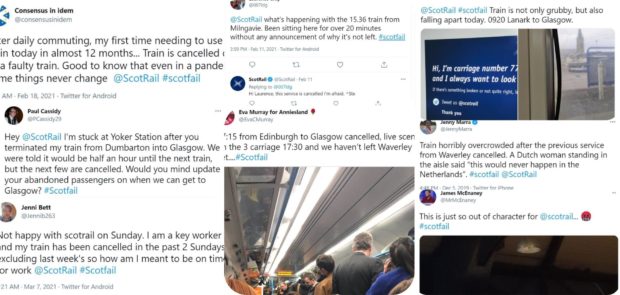News of the Scottish Government nationalising ScotRail services will have left many with mixed feelings.
For the thousands of social media savvy commuters, who made their displeasure known daily through the “ScotFail” hashtag, it may have come as a relief.
But others familiar with previous government takeovers, such as the huge sums poured into Prestwick Airport, fear millions more could be spent with no guarantee of an improved service.
Transport minister Michael Matheson confirmed in March the nation’s rail service will be run by an arm’s length company owned and controlled by the Scottish Government.
It follows the decision to end the contract with Abellio three years earlier than expected.
But can the Scottish Government do any better than the much-maligned Dutch firm?
No more shareholders
The Rail Delivery Group (RDG), which represents train operators across the UK, do not believe it’s a clear cut call.
Andy Bagnall, RDG director general, said he believes in “empowering private operators”.
“With Albellio as a partner, ScotRail has invested £475 million in new and upgraded trains which are providing a better service across Scotland,” he said.
“Despite the challenging commercial environment caused by the pandemic, the best way to encourage future train travel and support a green recovery is by empowering private operators.
“They have doubled journeys in 20 years because they know their customers best — and will invest, innovate and run better services that attract more passengers again in the future.”
Throwing a party on the day Abellio’s ScotRail contract officially ends #ScotFail
— Sam Waite (@SamWaite88) January 5, 2020
Neil Robertson, chief executive of the National Skills Academy for Rail (NSAR), said the private sector model “has developed a number of benefits”.
“Specifically in driving passenger growth and delivering new trains because they have entered into long-term relationships with train suppliers.
“The challenge will be to take the best of that going forward.
“The downside to privatisation is that you have got shareholders and profit margins to take into account and you have to pay those shareholders.
“Under state control there tends to be just one profit and loss account.”
The not-for-profit NSAR group does not have an official stance on privatisation over state ownership, but does recognise there are benefits and challenges to either route, he added.
‘ScotFail’
Commuters have made their voices heard on social media about the quality of existing services.
In the past decade, social media users took to using the pun “scotfail” to air their grievances at late, cancelled and overcrowded trains.
Our social media analysis found ScotRail’s Twitter account has apologised to customers on a near daily basis — with several days requiring a litany of apologies.
Pre-pandemic, between 15-20% of tweets sent out by the account had some form of remorse in it — such as apologising for delayed or cancelled trains.
This figure took a predicable dip when lockdown was announced and there were fewer journeys and travellers. However, this started slowly creeping up again as lockdown measures were eased over the summer, before plummeting again when further restrictions were imposed.
The worst days in the past 18 months were:
- September 25 2019 — 70 tweets expressing a form of regret
- October 4 2019 — 66
- October 25 2019 — 77
- November 13 2019 — 69
- November 15 2019 — 69
- November 19 2019 — 75
- November 21 2019 — 84
- November 30 2019 — 62
- December 11 2019 — 66

Best of both worlds
A rail insider with a national industry body, with an oversight of all aspects of rail operations across the UK, said the ideal situation is a blend of state and private enterprises working together.
The expert, who asked not be named for this article, said: “If the Scottish Government had continued with Abellio, they would have still have had a whole lot of involvement, in setting the conditions in the contracts if nothing else.
“Even in a situation where a state takes over the running of a network, the best thing they can do is let decision making happen closer to the ground level. The people who see the customers are often the best people to make decisions.
“When you involve government ministers it can become too political.
“But state involvement can bring some positives. You are seeing that happening in some parts of England now.
“But I would say generally the situation is better now with franchises than it was under British Rail.”
‘Understand and respond to local needs’
The Community Rail Network, a collection of local groups who have adopted ownership of stations in their towns, said they will continue to work with industry bodies — whoever is running the show.
“Community rail partnerships and station volunteers across Scotland will continue to work closely with our rail industry and government partners through the changes ahead, and as we rebuild from the pandemic, to connect communities with their railways,” a spokesman said.
“Community rail has been working with ScotRail through the pandemic to help them understand and respond to local needs, and is looking forward to bringing communities together and promoting sustainable travel by rail as part of a green and inclusive recovery.”
‘Ensure long-term funding’
Independent campaigners Railfuture Scotland insist they do not have a preference on who runs the railways — as long as they are run well.
Jane Ann Liston, secretary for the volunteer group, said: “The important thing is that the trains run where people want, when people want and at a reasonable cost.
“Any nationalisation of the railways would have to ensure long-term funding for the industry, avoiding the situation where British Rail did not know almost from year-to-year how much support they would receive.
“It would be essential that the railways are not used as a political football, as happened in the days of British Rail, often under the control of a transport minister such as Richard Marsh — who admitted he had neither knowledge nor interest in them.”
‘A smooth transition’
ScotRail has insisted travellers can be “reassured” about future service as the changeover happens.
Alex White, chief operating officer for the firm, said: “We will continue to operate a reliable service for key workers and support the vaccine rollout over the coming months as we prepare for the introduction of the changes announced by the Scottish Government.
“We will work closely with Transport Scotland and Network Rail to ensure a smooth transition to the new operator to deliver stability for customers and staff.
“Since Abellio was awarded the ScotRail franchise in 2015, Scotland’s railway has been transformed.
“The £475 million investment in new and refurbished trains, alongside our recent sustained, high levels of punctuality has delivered for customers, particularly during the pandemic. Our customer satisfaction scores are testament to that.
“We’ve also invested in Scotland, employing 5,200 people in high-skilled, well paid jobs.”
Abellio did not respond to a request for comment.
A history of nationalisation under the SNP
ScotRail is not the first time Holyrood has chosen to step in since the SNP came into power more than a decade ago.
Here are the biggest projects Holyrood has had to get involved in.
Prestwick Airport
Perhaps the most notorious example, the Scottish Government bought the west coast airport for £1 in 2013 when then owner Infratil failed to secure a private buyer.
More than £40 million of tax-payer money has been ploughed into the flailing airport.
The government announced their intention to sell Prestwick in 2019, with a preferred bidder selected in February 2021. The identity of the buyer has yet to be made public.
Ferguson Marine
The Clyde-based shipyard was nationalised in 2020 after it fell into administration, putting jobs at risk.
It was nationalised last year, despite records from 2005 indicating its demise was “close to irreversible”.
The tax-payer is owed nearly £50 million after the government invested to keep the site afloat.















